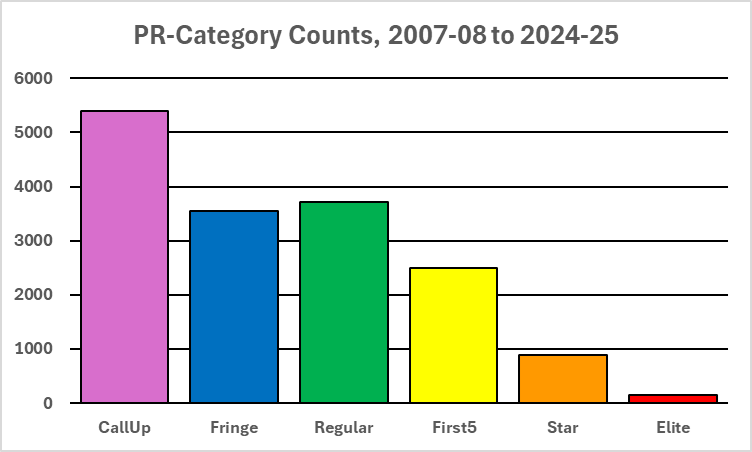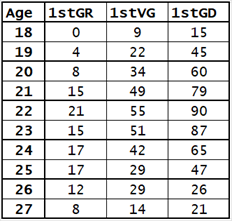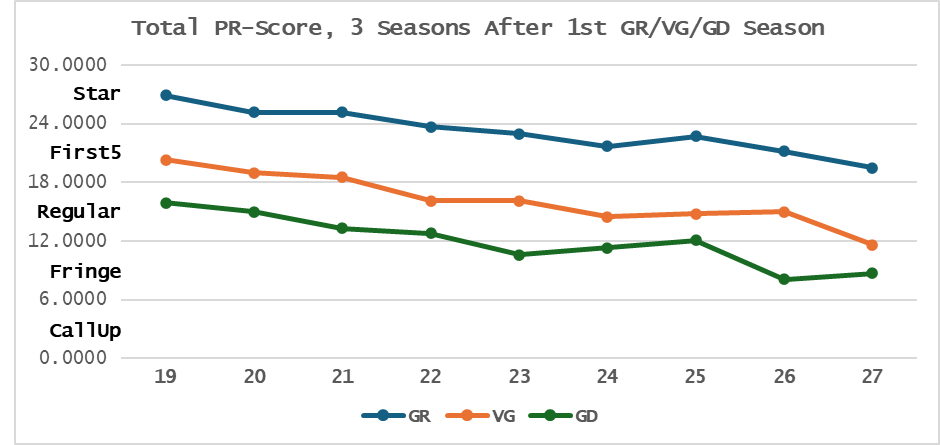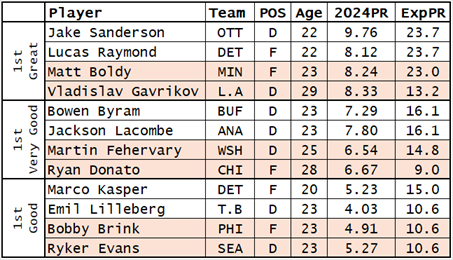An earlier Stapled To The Bench (STTB) article looked at player careers based on ages and levels of success (Early Success is a Good Omen). It found that the earlier a player was a good player, the better his future was.
That article’s title was chosen to create an acronym: ESIAGO. It sounds like asiago, a cheese, and it must be admitted that it is a cheesy acronym. This time around, there will be no cheesy acronyms.
In this article, players will be grouped by their age in their first great/very good/good season. The total PR-Score from their next three seasons will be determined, and a nice graph will wrap things up. Spoiler alert: Early success is still a good omen.
This article was written during July and August 2025.
Type of Season Breakdown

For this article, we are looking at seasons that were PR-Regular or better, shown in the four right-most columns in the PR-Category Counts table. The height of a column represents the number of players who have had that type of season. For example, there have been 5,402 PR-CallUp seasons and 138 PR-Elite seasons.
The green column, PR-Regular, will be considered a good season. Next to it is the yellow PR-First5 season, which will be considered a very good season. Finally, the orange and red columns, representing PR-Star and PR-Elite seasons, will be considered great seasons.
“First” Great/Very Good/Good Season
To qualify for consideration as a GR/VG/GD season, the player must have been born in or after 1989. The detailed data for PR-Score only goes back to the 2007-08 season, and without the year-of-birth qualification, there would be a lot of 2007-08 players having their “first good season” at an advanced age. For one example, Sergei Gonchar had a PR-Elite season at the age of 33 in 2007-08. Obviously, he had GR/VG/GD seasons before 2007-08.
A second qualification is that the season must have happened in or before 2021-22. STTB is looking at the three seasons after a specific season, and 2021-22 is (presently) the last season that has three seasons of following data.
There are also some logical restrictions. A player cannot have a “first good season” if he has already had a “first very good season” or a “first great season.” At age 18, Aaron Ekblad’s first season was a PR-First5 season (PR-Score of 7.31). At age 20, he had his first PR-Regular season (because he missed 14 games). Ekblad had already shown he was better than a good player, so his inclusion in the “first good season” category would inaccurately increase the outlook of players in it.
Similarly, a player cannot have a “first very good season” if he has already had a “first great season.”
First GR/VG/GD Season, Counts by Age

This table shows the count of how many players had first great seasons (1stGR), first very good seasons (1stVG) and first good seasons (1stGD).
All groups had their biggest population at the age of 22. The 1stVG and 1stGD counts for ages 21 and 23 were reasonably close to the age 22 count, while the same counts for 1stGR are a bit further away from its age 22 count. Whether the difference in the 1stGR counts is caused by the small number of 1stGR seasons or by some aspect of having a great season is unknown.
As players during their careers, they can appear in more than one category. Ryan Nugent-Hopkins appears in all three columns: his 1stGD season came at age 18, his 1stVG season came at age 20, and his 1stGR season came at age 25.
Because no 18-year-old has had a PR-Star or better season (the count is 0), the table in the next section starts at age 19. The best age-18 seasons belong to Aaron Ekblad (PR-Score 7.31), Nathan MacKinnon (7.16), Jeff Skinner (7.05) and Matt Duchene (7.00).
STTB finds the cell counts to be on the small side. As you are about to see, these small cell sizes did not produce messy results. Age-to-age changes are reasonable, and group-to-group differences are realistic.
Outlook After First GR/VG/GD Season

The words in the vertical axis (Star, First5, etc.) define the spaces between the gridlines. PR-First5, for example, is for PR-Scores between 6.0000 and 7.9999. Over three seasons, the range would be 18.0000 to 23.9999. A 23-year-old player having his first very good season (orange VG line, age 23) has an expected future that is approximately the same as three high PR-Regular seasons.
Be aware that the future PR-Scores include cases where the qualifying player missed games due to injury in his subsequent seasons. Due to injuries, estimated futures are a little on the pessimistic side.
We can infer two ideas from the chart.
Inference #1: The earlier a player achieves a level of success, the better his future will be. The line for all three groups descends as age increases.
Inference #2: The better a player is, the better his future will be. A 22-year-old player who just had his first great season has a better future than a 22-year-old who just had his first very good season, who in turn has a better future than a 22-year-old who just had his first good season.
To finish up this article, I’d like to talk about some current players who just had their first GR/VG/GD seasons.
2024 Players of Interest
Let’s now look at four players from each “first GR/VG/GD season” and consider their futures. The row shading in the table is used to make it easier to trace individual players’ data. ExpPR is the total expected PR-Score for a player for the coming three seasons.

There were only four players who had their first great season in 2024-25, and they are all included. The players in the remaining groups were selected from larger populations.
The first two lines show a slight weakness in the way a player’s potential future is estimated. While Sanderson and Raymond were both PR-Star level players, Sanderson was near the very top of that group, and Raymond was near the very bottom. They obviously shouldn’t have identical estimates: Sanderson’s should be higher.
If I had tried to be more specific on which historic players should be used to set the expectation for a current player, I would run into a small-n problem. Presently, there are only 21 players who had a first great season at age 22; there would be far fewer players who would be “tight matches” for Sanderson and Raymond. I am leery of making math-based predictions based on very small sets of donors.
If I tried to be more specific on a player’s level of play, I run into the same small-n problem. If I broke each category in half, then Sanderson would be in the upper first-great season group and Raymond would be in the lower first-great season group (the split would be in the middle of a PR-Category, which is 9.0000 for these two players). There are only seven players in the upper group, fourteen in the lower group.
The STTB prediction for these two players is that they will each accumulate 23.7 PR-Points over the next three seasons. Personally, I think that the prediction for Sanderson is pessimistic and that Raymond’s prediction is optimistic.
Vladislav Gavrikov’s future expectation (13.2 PR-Points) is markedly lower than Matt Boldy’s (23.0), because Gavrikov is quite old for a hockey player at 29. Age-29 information was calculated but not included on the chart, as the number of donors was low.
Because of their age, Byram, Lacombe and Fehervary all have higher expectations than Gavrikov, even though their first very good seasons were not nearly as good as Gavrikov’s first great season. That’s an age thing. In the NHL, 23-year-olds can and do improve, but 29-year-olds are almost certain to decline. Three years from now, Byram and company will all be 26, but Gavrikov will be 32.
The four players representing those who just had their first good season have higher expectations than Ryan Donato: that’s the same age thing again. The three 23-year-olds have the same expectation, even though they had different levels and even though they played different positions.
I didn’t control for position in this research. I have a feeling that if I had controlled for position, defensemen would have lower expectations and forwards would have higher expectations because defensemen get injured more frequently.
Summary
I was extremely confident that this update would echo the findings of the earlier article. The game of hockey has not significantly changed in the last three years, and neither have the hockey players (as a group of about 1,000 players a year).
The chart in the Outlook After First GR/VG/GD Season section has much in common with a chart in the Age and Value Rating article. Using different measures and different approaches, both articles show that players decline as time goes on, and both also show that players with higher skill levels have better futures than those with lower skill levels.
The earlier a player is very good, the longer he will be a very good player.
Related Articles
